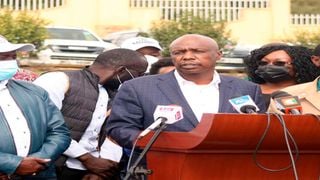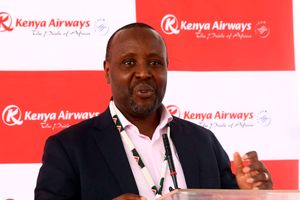
OKA principals Kalonzo Musyoka,Gideon Moi and Moses Wetang'ula at a past press briefing. A presidential run-off is likely this year should OKA field a candidate or have its principals run for State House separately.
| File | Nation Media GroupPolitics
Premium
How OKA bid could force a run-off in State House race
A presidential run-off is likely this year should One Kenya Alliance (OKA) field a candidate or have its principals run for State House separately.
The two top contenders in the August 9 race are even more likely to face off a second time should there be low voter turnout in Mt Kenya or if Azimio la Umoja leader Raila Odinga manages to secure a significant part of the region’s votes.
Should these factors come into play, and barring a radical shift from the 2013 and 2017 voting trends, neither Mr Odinga nor Deputy President William Ruto, the perceived front runners in President Kenyatta’s succession, is likely to secure a first-round win.
The DP is under pressure to replicate Jubilee’s performance in the past two elections, where victory was secured courtesy of overwhelming voter turnout in Mt Kenya, which was as much as 94 per cent in some counties.
In both elections, the 10 Mt Kenya counties accounted for more than half of the total votes the President and his deputy garnered, which underlines the bloc’s significance in helping the two avoid a run-off.
50 per cent plus one
The Constitution stipulates that for anyone to be declared the winner of a presidential contest, he or she must garner at least 50 per cent plus one of the total votes cast. He or she must also bag at least 25 per cent of the votes cast in not less than 24 counties.
Should none of the candidates meet the threshold, there has to be a rerun between the two leading contenders within 30 days of the General Election.
The 2013 General Election recorded a high voter turnout of 86 per cent, with the President and his deputy surpassing the first-round-win threshold by a narrow margin of 8,000 votes.
President Kenyatta got 6,172,482 votes (50.07 per cent) against Mr Odinga’s 5,340,546 (43.31 per cent).
Of the 6.2 million votes, the President secured, 3.2 million (52 per cent) from Nyeri, Kiambu, Kirinyaga, Meru, Embu, Tharaka-Nithi, Murang’a, Nyandarua, Laikipia and Nakuru counties.
In 2017, President Kenyatta widened the lead over Mr Odinga, polling 8,203,290 votes (54.27 per cent) against the former prime minister’s 6,762,224 votes (44.74 per cent). Of the 8.2 million votes, the President got, 4.1 million (50 per cent) from the 10 counties, in an election that recorded an average of 78 per cent voter turnout.
Election nullified
The Supreme Court, however, nullified the election and Mr Odinga boycotted the repeat exercise in which the President was largely re-elected by his strongholds.
Failure by the Mt Kenya region to turn up in large numbers, and a possible decision by OKA to be in the race likely to chip off quite a bit of Mr Odinga’s 2013 and 2017 support bases in Ukambani, Coast and Western Kenya, would make it difficult for either candidate to secure an outright victory.
Ominously for Dr Ruto, the factors that contributed to the overwhelming voter turnout in Mt Kenya are unlikely to hold, especially with developments such as the falling-out between him and his boss.
Another great risk of voter turnout dipping in Mt Kenya is that the region is unlikely to have a presidential candidate for the first time since 1992.
The anti-Raila sentiment of past years also seems to be increasingly fading, following the rapprochement with President Kenyatta, who is believed to be backing the ODM leader’s presidential bid.
The fact that past vocal critics of Mr Odinga are campaigning for him in Mt Kenya means that every additional vote Azimio la Umoja might get in the region will be at the DP’s expense.
Were Mr Odinga to secure even 30 per cent in the 10 Mt Kenya counties alone, that would work out to an additional 1.3 million votes, which could tip the scales in his favour. But this is only possible if he holds onto his 2013 and 2017 strongholds, which would be a tall order should OKA have its own in the State House race.
“A run-off might become a reality if Mt Kenya people decide to field a presidential candidate. If that candidate gets 60 per cent, maybe 70 per cent of the vote, it would completely destroy DP Ruto’s arithmetic,” political analyst Herman Manyora said.
Campaign slogan
It is perhaps out of the realisation that he can’t bank on the Mt Kenya and Rift Valley vote blocs this time that Dr Ruto has latched onto the “Hustler Nation” campaign slogan, which he says transcends tribal voting patterns.
Matters are, however, more complicated for Mr Odinga. The ODM leader begins at a disadvantage given that he polled below 50 per cent of the national vote in the past two elections.
And while he may gain in Mt Kenya, he would lose his Ukambani support base were Mr Musyoka to run as the OKA candidate or independently and still maintain a stranglehold on the Lower Eastern vote.
Although Mr Odinga enjoys the support of Ukambani governors Charity Ngilu (Kitui), Kivutha Kibwana (Makueni) and Alfred Mutua (Machakos), Mr Musyoka has proven in the 2013 and 2017 polls that he politically controls the region.
Kitui, Makueni and Machakos counties collectively gave Mr Odinga 768,025 votes in 2013 and 968,437 votes in 2017. With the region’s vote expected to increase to 2.1 million, the Ukambani bloc is perhaps the single biggest bloc bankable by someone other than Mr Odinga and Dr Ruto.
Were the entire bloc – or a significant part of it – to be chipped off Mr Odinga’s tally, the chances of the ODM boss hitting 50 per cent of the national tally would grow even dimmer.
Push to back Odinga
Perhaps this explains President Kenyatta’s push to have OKA back Mr Odinga.
Prof Kibwana argues that OKA is out to spoil the party for the other candidates.
D“OKA’s presidential bid presents itself as an attempt to force a 2022 presidential election run-off, not to secure the coalition’s victory. That is a gamble, as subsequent entry into the winning team will also be dicey. Kenyans will not vote for those who are unlikely to win,” opined Prof Kibwana.
In the final analysis, voter turnout and voting trends in Mt Kenya as well as political developments in Ukambani will be key determinants of the outcome of the August 9, 2022 General Election.
Registered voters
The most recent tally of registered voters shows DP Ruto’s Rift Valley leads with 5.09 million, Central (3.04 million), Nyanza (2.9 million), Nairobi (2.4 million) and Western (2.08 million).
Coast, on the other hand, has a total of 1.85 million voters, Upper Eastern (1.54 million), Lower Eastern (1.6 million) as North Eastern trails with 572,116 voters.
At 2.4 million, Nairobi City County has the highest number of voters, followed by Kiambu (1.24 million), Nakuru (1.01 million), Kakamega (801,552), Meru (750, 335), Machakos (659,829), Mombasa (621,791), Bungoma (611, 054), Murang’a (610,336) and Kisii (603,512).
Some of these areas have in the past been behind Mr Odinga, but a spirited campaign by Jubilee Party prior to the 2017 elections not only increased the ruling party’s foothold, but also showed they were potential battle zones.
In Nairobi, which had 2.2 million votes, the gap between President Kenyatta and Mr Odinga remained almost the same – 32,000 in 2013 and 37,000 in 2017 in favour of Mr Odinga.
In 2017, Mr Odinga garnered 801,031 votes against President Kenyatta’s 287,606 in the six coastal counties, even though the Jubilee leader had increased his tally in the region.
In Maasailand, President Kenyatta won Narok (149,376 votes) against Mr Odinga (129, 360 votes) and retained the neighbouring Kajiado (186, 481) against Mr Odinga (138, 405).
The Jubilee leader also won Samburu by a whisker, polling 31,746 up from 22,085 votes in 2013, with Mr Odinga adding just over 500 votes from 31,086 to 31,615 in 2017.
In Gusiiland, President Kenyatta surprisingly surged past Mr Odinga in Nyamira, getting 106,508 votes against Mr Odinga’s 95,277, in a county where he had only polled 29 to 69 per cent of the votes in 2013.
Overall, President Kenyatta’s votes dropped in 24 counties in 2017 compared to 2013. His tally increased in 22 counties while that of Mr Odinga shrank in 31 counties, with an increase in only 11.
In 2017, President Kenyatta swept northern Kenya, upstaging Mr Odinga in Garissa, Isiolo and Wajir from the 2013 contest while retaining Mandera County.





